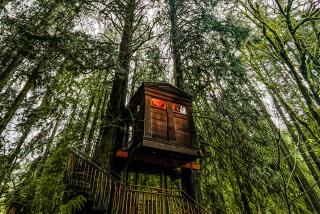Centuries later, the hammock is still swinging
APOLOGIES TO the hammock. It always seemed an object of indolence -- a garden metaphor for idle hours spent horizontal, swinging in a breeze.
Au contraire.
The simple little sling has survived for more than 1,000 years because it has been a workhorse and comfort for millions who have used it as a bed, birthing table, cradle, sofa -- even as a final resting place. In some cultures, the hammock has accompanied individuals from cradle to grave.
The first hammocks were made in Central America centuries ago by people who pounded the bark of the hamak tree and wove it into a hanging haven. Later, they switched to sisal and fabric, which were softer and more comfortable.
By the late 1400s, when Columbus dropped anchor in the Americas, hammocks were in regular use. By night, they were beds. By day, they fulfilled the family’s other furniture needs. Fascinated by this humble multipurpose item, Columbus tried it, pronounced it good and brought hammocks home to Europe.
In the 1500s, Fernandez de Oviedo y Valdez documented the customs and culture of Central America’s indigenous peoples. “The Indians sleep in a bed they call an hamaca,” he wrote, describing the design as a net with twine strings at both ends that could be hung at any height. “They are good beds and clean,” he added, and portable enough for small children to carry. They kept sleeping families off the earth floors of their huts, where snakes, spiders and other creatures wandered through.
When hammocks arrived in Europe, they became the staple beds for sailors. The trend lasted for centuries, through the 1940s and World War II, when U.S. warship crews slept in string hammocks often stacked vertically to accommodate more sleepers in less space. U.S. soldiers in the Pacific were issued jungle hammocks that had protective mosquito nets.
A fever for hammocks as outdoor furniture hit the United States in the late 1800s, when homeowners across the country decided they were the height of fashion for garden and porch. The addition of wooden spreaders to keep hammocks flat and easier to use came in the 1900s. Distinctive variations have emerged throughout South and Central America, depending on climate. Mesh or net hammocks provide a ventilated bed in warm areas. Thick cotton or wool hammocks are found in colder ones.
In 1996, James Bogan -- professor at the Missouri University of Science and Technology, poet and frequent traveler to Brazil -- wrote that even today, residents of the Amazon call their hammocks “old mother,” a reference to the way hammocks seem to embrace and envelop sleepers in comforting arms.
“Born in the jungle by the shores of a river, the newborn sleeps his first sleep in the hammock as his grandfather will sleep his last,” Bogan wrote in an essay. “Then, as is our ancient custom, we bury the dead lying down in their own hammock. We are born, we live, we love, we die in the hammock.”
The hammock lives on, Bogan said by phone from his home in Rolla, Mo., “because no one’s ever invented anything better. And no one ever will.”
More to Read
Sign up for our L.A. Times Plants newsletter
At the start of each month, get a roundup of upcoming plant-related activities and events in Southern California, along with links to tips and articles you may have missed.
You may occasionally receive promotional content from the Los Angeles Times.






